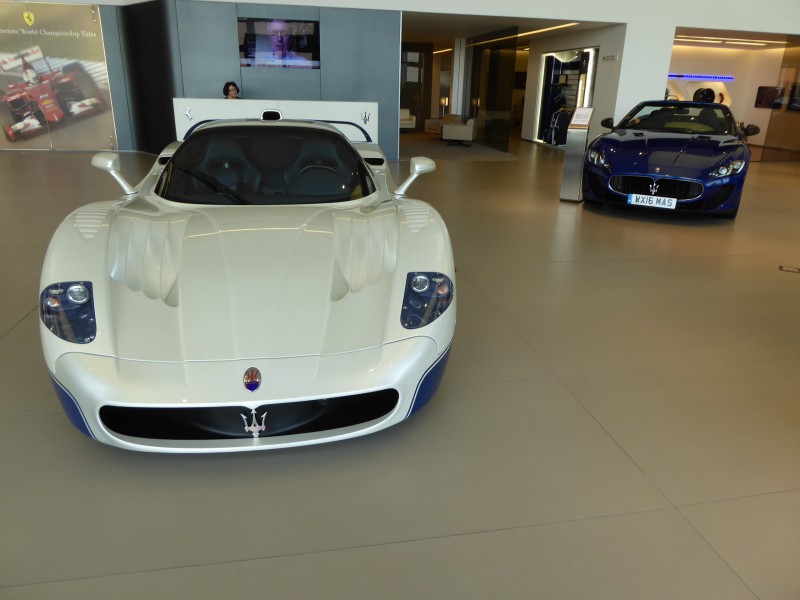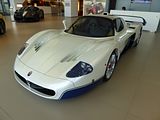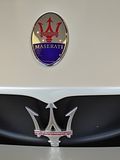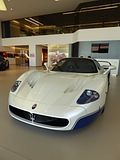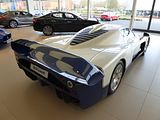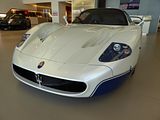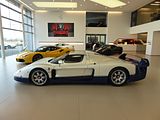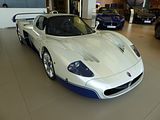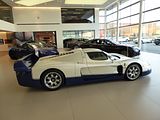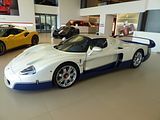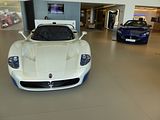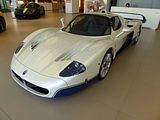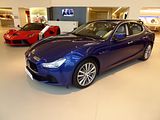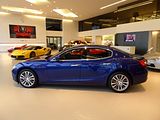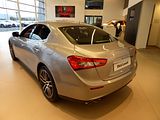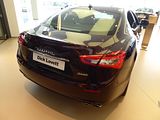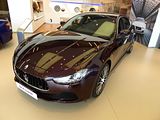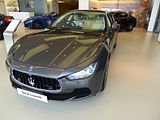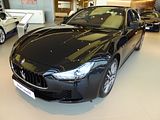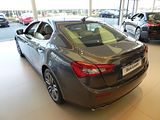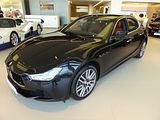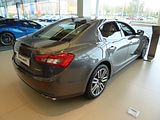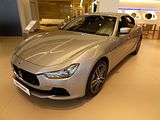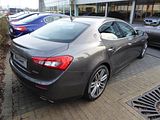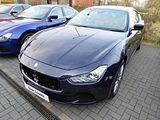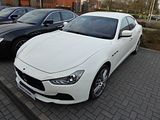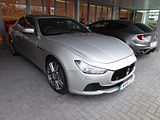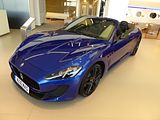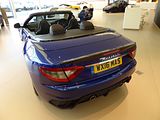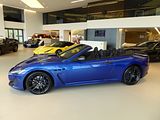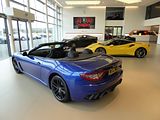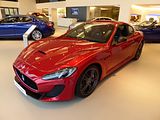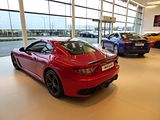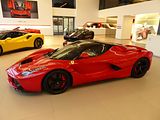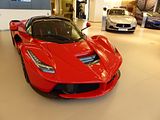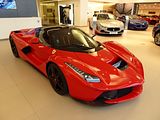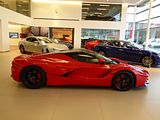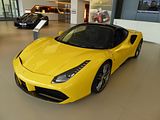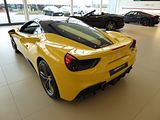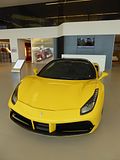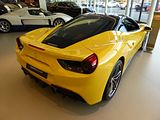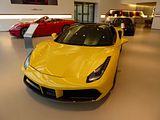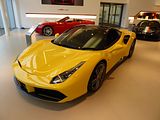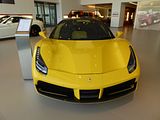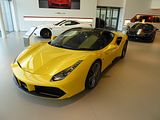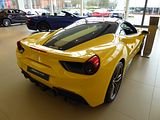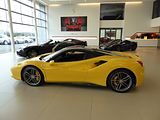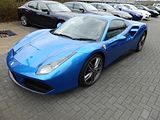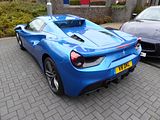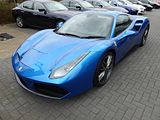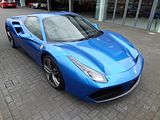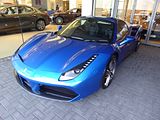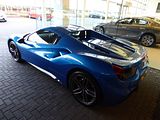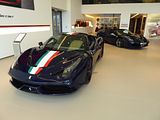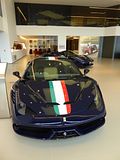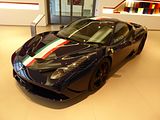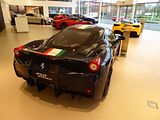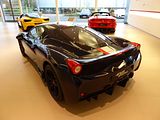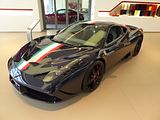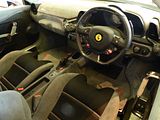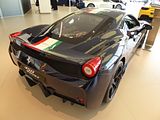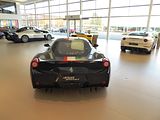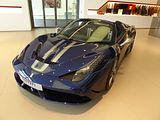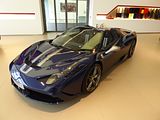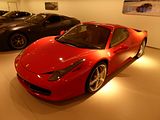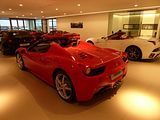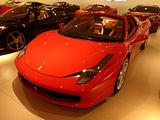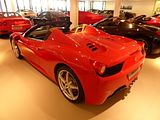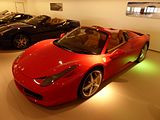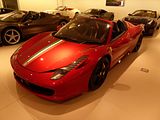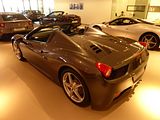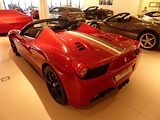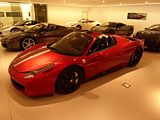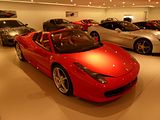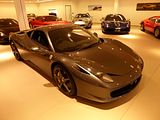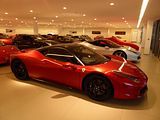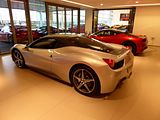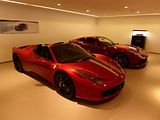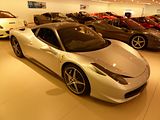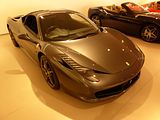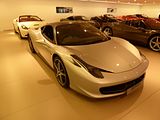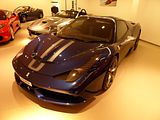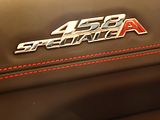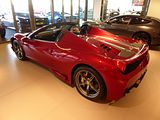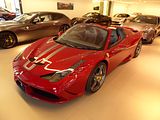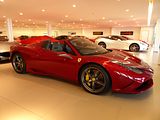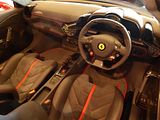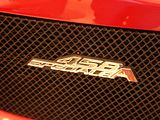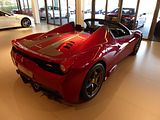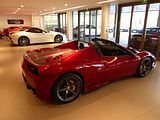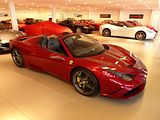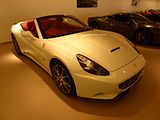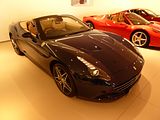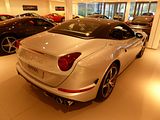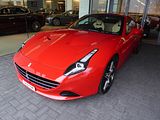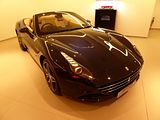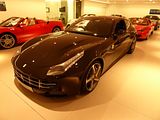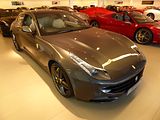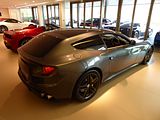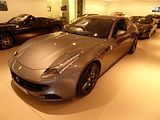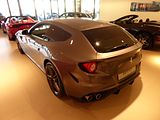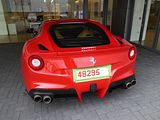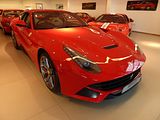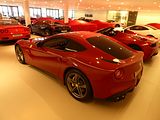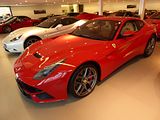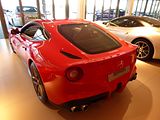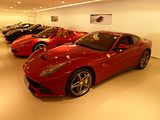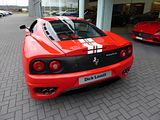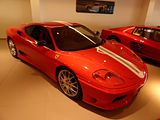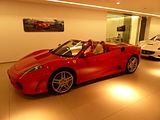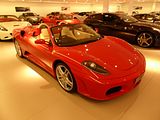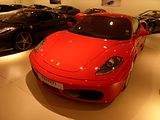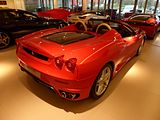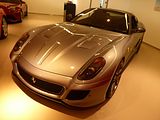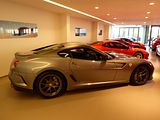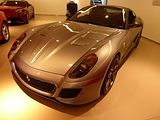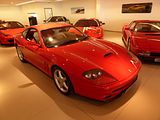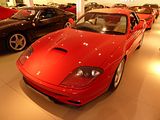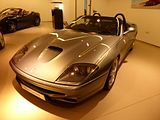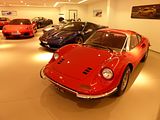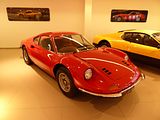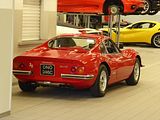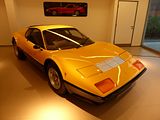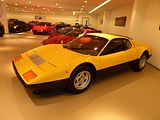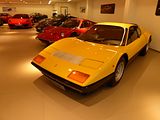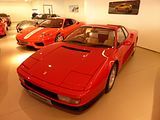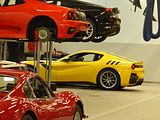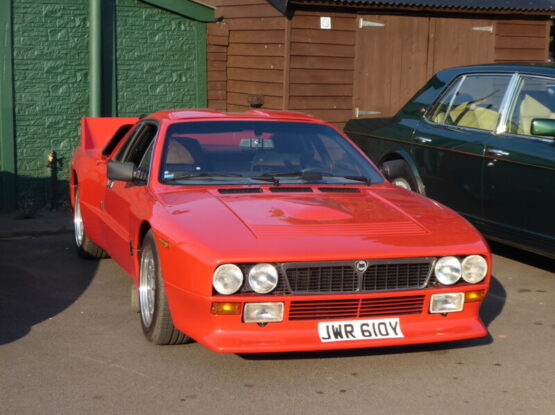If you are a lover of fine automobiles, and given that you are reading this, then it is a reasonable assumption that you are, and especially if you live in the south of England, chances are you will have heard of Dick Lovett, or maybe even paid a visit to one of their showrooms. In fact, 2016 marks the 50th anniversary of the establishment of the car sales franchise which bears its founders name. The origins of the company go back even further than that, to 1959, and the partnership set up by Dick Lovett and his wife, Stella. which was called Ross Motors. The business was based in Leicester and initially sold motorcycles, although Dick’s passion for sports cars saw him buy and sell models to other enthusiasts. The Lovetts lived above their business and would be on hand to cater for enquiries from all over the British Isles. The business continued to develop into the 1960s and in 1966 Dick moved the company to the South West of England and began trading under his own name from the family home in Wroughton, near Swindon. By this stage he was selling cars such as the Lamborghini Miura, the Ferrari 250 SWB and other such specialist cars, one of very few dealers in the UK in the mid 1960s to do so. The company continued to expand, and in 1968, acquired a franchise to sell BMW cars, a brand which until that point was little known in the UK, and whose strongest associations in the UK were through Frazer Nash and the AFN Group. In 1971, when the official Porsche Centre network was set up, Dick Lovett was one of the initial partners, and has been ever since. Like his father, today’s Chairman, Peter Lovett, is passionate about sports cars, which grew from an aspiration to compete in motorsport. As Peter became more involved in the family business, he also began competing on the track to satisfy this desire. He raced a Rover Vitesse SD1 in the British Saloon Car Championship between 1981 and 1983, winning a number of races against famous drivers including Jeff Allam, Steve Soper and Martin Brundle. He has also represented Wiltshire in the BMW County Championship, racing BMW 323i Saloons. Peter’s true motorsport love was found competing at the ’24 Heures du Mans’ (Le Mans), which he did this six times during the 1970s and 1980s racing legendary race cars such as the Porsche 911 Carrera RSR, Lola T380, Porsche 935 K3, Mazda RX-7 and Mazda 717c. During this time he also competed at the Spa 24 Hours event four times, and this appetite for endurance may explain his four decades at the head of the business. Such associations mean that it was almost inevitable that the Group would look to other marques with a rich heritage in motorsport, from Italy. The relationship with Ferrari and Maserati stretches back to the 1970s and 1980s when the Group first started officially representing them for a short period, and this was resurrected in 2002 when both Ferrari and Maserati selected the Group to be their representative in Swindon. As well as continuing to represent BMW (and these days that means MINI as well) and Porsche, Dick Lovett will be adding an Aston Martin showroom to their portfolio later in 2016, in Bristol. With over 600 staff, the company has come a long way since those early beginnings, with a number of modern purpose-designed showrooms not just in the Swindon area, but also in Tewkesbury and Cardiff, where Porsche are sold, but Bristol and Hungerford for BMW and MINI. In recent weeks I have paid a couple of visits to perhaps the flagship of the lot, the facility which sells and services Ferrari and Maserati, situated right alongside the M4 on the western side of Swindon. When I asked if it would be OK to take photos, the answer I received was that they would almost be disappointed if I did not want to! So, of course, I did, and this report presents some of the utterly droolsome cars which were on site during those visits.
MASERATI
Let’s start with what for me is the very best of the lot, though I do realise that there will be plenty who would pick something else out from the selection of cars depicted here. This is a 2004 Maserati MC12. When I visited in January, I could see the tantalising outlines of it parked upstairs in an area which is not generally open to the public, but in early March, the car had been moved downstairs and was – quite rightly – occupying prime position in the centre of the showroom. I asked if it belonged to Dick Lovett, or whether it was simply being stored for a customer, and the answer came back that it was for sale. The asking price was £1.5 million, which may sound like a lot. But think about what this car is, and you will probably conclude that whilst this is not exactly the bargain of the year, that is probably a reasonable deal. For a start, only 50 of these cars were made, half in 2004 and the others in 2005, so it is far more exclusive than an Enzo. Developed to signal Maserati’s return to motor sport after a gap of 37 years, the MC12 was developed to allow a racing variant to compete in the FIA GT Championship. To be able to enter, Maserati needed to produce a limited number of road car versions as well, 25 being the required number, but in the end a second batch were made, and all 50 of these were offered to customers at €600,000, which was a lot of money back in 2004, the pre-Veyron era. Development of the racing version – initially called the “MCC” (“Maserati Corse Competizione”) and the road car, the “MCS” (“Maserati Corse Stradale”) was undertaken in parallel. Frank Stephenson did the majority of the body styling, but the initial shape was developed during wind tunnel testing from an idea had by Giorgetto Giugiaro. The MCC has a very similar body shape to the MC12, but there are several key differences, most notably the rear spoiler. Andrea Bertolini served as the chief test driver throughout development, although some testing was done by Michael Schumacher, who frequently tested the MCC at the Fiorano Circuit. During the development process, the MCC name was set aside after Maserati established the car’s official name, MC12.The car is based heavily on the Enzo Ferrari, using a slightly modified version of the Ferrari Dino V12, the same gearbox (but given the unique name of “Maserati Cambiocorsa”) and the same chassis and track. The windscreen is the only externally visible component shared with the Enzo. The MC12 has a unique body which is significantly wider, longer and slightly taller but more aerodynamic than the Ferrari and with greater levels of downforce It is physically a large machine indeed, being wider than a Hummer H2!. The body of the car, made entirely of carbon fibre, underwent extensive wind tunnel testing to achieve maximum downforce across all surfaces. As a result, the rear spoiler is two metres wide but only 30 mm thick, the underside of the car is smooth, and the rear bumper has diffusers to take advantage of ground effect. Air is sucked into the engine compartment through the air scoop; its positioning on top of the cabin makes the car taller than the Enzo. The exterior is available only in the white-and-blue colour scheme, a tribute to the America Camoradi racing team that drove the Maserati Tipo Birdcages in the early 1960s. The car is noted for the awkwardness that results from its size; very long and wider than a Hummer H2. This, combined with the lack of a rear window, can make parking the MC12 challenging. There is a targa top roof, although the detached roof cannot be stored in the car. Even though the car is designed as a homologation vehicle and is a modification of a racing car, the interior is intended to be luxurious. The interior is a mix of gel-coated carbon fibre, blue leather and silver “Brightex”, a synthetic material which was found to be “too expensive for the fashion industry”. The centre console features the characteristic Maserati oval analogue clock and a blue ignition button, but it has been criticised for lacking a radio, car stereo or a place to install an aftermarket sound system. The MC12 is powered by a 5,998 cc Enzo Ferrari-derived V12 engine, mounted at 65°. Each cylinder has four valves, lubricated via a dry sump system, and a compression ratio of 11.2:1. These combine to provide a maximum torque of 652 Nm (481 lb/ft) at 5500 rpm and a maximum power of 630 PS (620 hp) at 7500 rpm. The redline is indicated at 7500rpm —despite being safe up to 7700—whereas the Enzo has its redline at 8200 rpm. Power is fed to the wheels through a rear-mounted, six-speed semi-automatic transmission. The gearbox is the same as the Enzo’s transmission (tuned to different gear ratios) but renamed “Maserati Cambiocorsa”. It provides a shift time of just 150 milliseconds, and is mechanical with a 215-millimetre (8.5 in) twin-plate dry clutch. Top speed of the Maserati MC12 is 330 km/h (205 mph) whereas that of the Enzo Ferrari is 350 km/h (217.5 mph).The Maserati MC12 can accelerate from 0 to 100 km/h in 3.8 seconds and on to 200 km/h in 9.9 seconds. It can complete a standing quarter mile in 11.3 seconds with a terminal speed of 200 km/h or a standing kilometre in 20.1 seconds. All this performance would be of no value if it could not be transmitted to the road and harnessed, and Maserati paid plenty of attention to that. The mid-rear layout, with the engine between the axles but behind the cabin, keeps the centre of gravity in the middle of the car, which increases stability and improves the car’s cornering ability. The standing weight distribution is 41% front and 59% rear. At speed, however, the downforce provided by the rear spoiler affects this to the extent that at 200 km/h the downforce is 34% front and 66% rear. The MC12’s chassis is a monocoque made of carbon and nomex, with an aluminium sub-chassis at the front and rear. It has a roll bar to provide additional strength, comfort and safety. Double wishbone suspension with push-rod-operated coil springs provide stability and dampers smooth the ride for the passengers. The front of the car can be raised for speed bumps and hills by pressing a button that extends the front suspension. There are two modes for the chassis’ tuning which can also be changed with a button in the cabin: “sport”, the standard setting, and “race”, which features less of the “Bosch ASR” (anti-slip regulation) traction control, faster shifts and stiffer suspension. The MC12 has 19 inch wheels with a width of 9 inches at the front and 13 inches at the rear. The tyres are “Pirelli P Zero Corsas”, 245/35 ZR 19 for the front and 345/35 ZR 19 for the rear. The brakes are Brembo disc brakes with a Bosch anti-lock braking system. The front brakes have a diameter of 15 inches with six-piston calipers and the rear brakes have a diameter of 13.2 inches with four-piston calipers. The centre-lock wheel nuts that hold the wheels to the chassis are colour-coded; red on the left of the car, blue on the right.
When new, the car received mixed reviews, with critics saying it is hard to drive, overpriced and too large. Other criticisms include the lack of a boot, rear window, spare tyre and radio, and the way the car’s engine was limited or “drugged”. Top Gear got their hands on one, and The Stig achieved a lap time of 1:18.9 around the Top Gear track – 0.1 seconds faster than his lap in the Enzo Ferrari. Host Jeremy Clarkson also drove it, comparing it to the Maserati Biturbo, a car he disliked intensely Clarkson criticised the car greatly, pointing out that, unlike the Enzo, it lacks a rear window. He also commented that it is “difficult” due to its size, and, “one of the twitchiest cars”, he has ever driven, meaning a small action by the driver results in an exaggerated reaction from the car. For these reasons, he promptly renamed the car “The MC Hammer”. Regarding the design of a racing car and modification to road standards he said, “is it a racer? Is it a GT car? Is it a de-tuned Enzo in a fat suit? You can’t really tell.”[20] Despite his criticisms he did compliment the smooth ride. Other journalists – and there were not that many who got the chance to try one – were more positive. In 2008 Evo Magazine ran the MC12 at Nordschleife and obtained a 7:24.29-second lap time, the second time an MC12 recorded a faster lap time than its Ferrari counterpart, with the Enzo lapping the track 1 second slower.
Although its road car credentials were sometimes called in doubt let’s not lose sight of the fact that this car was intended first and foremost for the track. and here it was pretty successful. In 2004 Maserati completed three MC12 GT1 race cars intended for the FIA GT GT1 class. The AF Corse factory-backed squad debuted the race at Imola, yet the FIA did not allow the MC12 to score points due to its debated homologation. Even with this setback, the team managed to take second and third places. At the next round at Oschersleben, the MC12 of Andrea Bertolini and Mika Salo won for the first time. At the final round of the year at Zhuhai, the FIA finally agreed to homologate the MC12s and allow them to score points towards the championship. With this, the MC12 again took victory, allowing it to score enough points to finish 7th in the teams championship. In 2005 Maserati won the FIA GT Manufacturers Cup with 239 points: almost double the score of next team (Ferrari with 125 points). The two teams that entered MC12s into the FIA GT, Vitaphone Racing and JMB Racing, finished first and second respectively in the Team Cup, with Vitaphone winning by a considerable margin. Four of the MC12 drivers were in the running to win the FIA GT Drivers’ Title at the Bahrain International Circuit at the start of the final race of 2005: Karl Wendlinger and Andrea Bertolini each on 71 points and Timo Scheider and Michael Bartels on 70. Gabriele Gardel of Ferrari was also on 70 points, however, and in the crucial race he placed ahead of all of the Maseratis, driving an older Ferrari 550 Maranello. Gardel took the title, leaving all of the Maserati drivers within four points of first place (Scheider and Wendlinger receiving four points for the race). In 2006 the only team representing Maserati was Vitaphone Racing. On September 30, 2006, Vitaphone secured the Teams’ Championship for the 2006 season despite their drivers placing 5th and 7th in the Budapest 500 km race with weight penalties of 85 kilograms and 105 kilograms respectively.Bertolini and Bartels also shared first place in the Drivers’ Championship on 71 points but the manufacturers cup went to Aston Martin. Vitaphone Racing again won the GT1 Teams’ Championship in the 2007 season on 115 points, followed by fellow MC12 team Scuderia Playteam Sarafree on 63 points. JMB Racing also entered two MC12s, but they were used by amateur drivers competing in the Citation Cup, which was won by JMB’s driver Ben Aucott. Maserati also won the Manufacturers’ Cup by a significant margin while Thomas Biagi won the Drivers’ Championship. Fellow Vitaphone drivers Miguel Ramos and Christian Montanari tied for sixth, while Playteam’s Andrea Bertolini and Andrea Piccini were just behind. For 2008, Vitaphone Racing returned with a pair of MC12s for drivers Andrea Bertolini, Michael Bartels, and Miguel Ramos, as well as newcomer Alexandre Negrão. The season ended with another Teams’ Championship for Vitaphone Racing (122.5 points) and Drivers’ Championship for Bertolini and Bartels. In the ninth round, the team fielded a third car under the name of Team Vitasystem, driven by Pedro Lamy and Matteo Bobbi which scored one point. JMB Racing retained a single MC12 for 2007 Citation Cup winner Ben Aucott and drivers Peter Kutemann and Alain Ferté, competing in the first five events of the championship. In the 2009 season the Vitaphone Racing won the fifth consecutive Team Championship, while Bertolini and Bartels gained their third Drivers’ Championship. The other two drivers were Miguel Ramos and Alex Müller, who ended in sixth position. Starting from the fourth round, the team entered a third car under the name of Vitaphone Racing Team DHL, driven by Matteo Bobbi and Alessandro Pier Guidi, achieving good results: despite being only a one-car team, with a partial season involvement, they ended the Teams’ Championship in fourth position (32 points), scoring a victory in the last round. With the inauguration of the FIA GT1 World Championship in 2010, Maserati continued their commitment to the series with two teams entering. Vitaphone Racing Team, the defending FIA GT Champions, won five races en route to the Drivers’ and Teams’ World Championships, but Maserati lost to Aston Martin in the Manufacturers’ Trophy. The second team representing Maserati was Alfrid Heger’s Triple H Team Hegersport. MC12s have had great success racing in Italy, and have replaced the GT3 “Maserati Trofeo Light” as Maserati’s representative in the Italian GT Championship. In 2005 Maserati introduced two MC12s to the GT1 division under Scuderia Playteam and Racing Box, with the teams placing first and third overall respectively. The cars were re-entered in 2006, with Scuderia Playteam again securing overall victory and Racing Box coming second. From 2007, GT1 cars are not permitted in the championship, and Scuderia Playteam moved to the FIA GT Championship. Racing Box also participated in the non-championship 6 Hours of Vallelunga twice, winning in 2005 with Michele Rugolo, Leonardo Maddelena, and Davide Mastracci, then again in 2006 with Pedro Lamy, Marco Cioci, and Piergiuseppe Perazzini.In 2006, the Le Mans winning outfit Team Goh was intending to race a Maserati MC12 in the Super GT series in Japan. However, the team was forced to withdraw because of driver problems (Jan Magnussen falling ill suddenly and returning to Denmark) and disappointing lap times at the Suzuka Circuit during testing. While the car was faster than its Super GT rivals down the straights, it was losing more than a second per lap in the corners due to its poorer aerodynamics. In 2004 the Maserati MC12s were unable to compete in series backed by the ACO, such as the Le Mans Endurance Series (LMES) in Europe and the American Le Mans Series (ALMS) because they exceeded both the length and width restrictions for their class. The car’s nose was shortened by 200 millimetres to attempt to comply with regulations, but was still 66 millimetres too wide. In 2005 the governing body of the ALMS, the International Motor Sports Association (IMSA), allowed the MC12s to compete as a guest with the agreement that they were not allowed to score championship points and were forced to run a weight penalty. Some ALMS teams initially objected to the participation of the MC12 due to the possibility that an accident could eliminate their chances at the 24 Hours of Le Mans, but the MC12 was finally allowed to race. The ACO stood by their ruling on the car by forbidding it from entering other Le Mans series. The lone MC12 would be campaigned under the Maserati Corse banner, but run by the American Risi Competizione team. The 2005 American Le Mans Series season was not as successful for the team, with the team scoring no wins. In the final race at Mazda Raceway Laguna Seca, the MC12 was clipped by a competitor, causing damage that resulted in a lengthy pit stop. After resuming the race, a loss of traction caused by cold tires made the car hit a curb, which broke the radiator and took the MC12 out of the race. In August 2007, Fredy Lienhard and Didier Theys announced their preparation of a former FIA GT MC12 for use in the American Le Mans Series. The car made its debut at Road America, finishing 3rd in the GT1 class after qualifying competitively. The only other race entered was Round 11 at Road Atlanta for the Petit Le Mans where the team failed to finish following an accident, but were still classified second in class. Doran’s Maserati however had qualified on the class pole. The team selected Michelin tires instead of the Pirellis originally used by Maserati Corse in 2005, and was also allowed to race with a full-width rear wing instead of the smaller wing used by Maserati Corse and teams in FIA GT, although the wing was not as tall. IMSA also allowed Doran to score points in the American Le Mans Series championships. The Corse is a variant of the MC12 intended for racetrack use. In contrast to the race version of the MC12, of which street-legal versions were produced for homologation purposes, the MC12 Corse is intended for private use, albeit restricted to the track, as the Corse’s modifications make it illegal to drive on the road. The Corse was developed directly from the MC12 GT1, which won the 2005 FIA GT Manufacturers Cup. The car was released in mid-2006, “in response to the customer demand to own the MC12 racing car and fueled by the growth in track days, where owners can drive their cars at high speeds in the safety of a race track”, as stated by Edward Butler, General Manager for Maserati in Australia and New Zealand. In similar fashion to the Ferrari FXX, although the owners are private individuals, Maserati is responsible for the storage, upkeep, and maintenance of the cars, and they are only driven on specially organized track days. Unlike the FXX, Corsas are not used for research and development, and are used only for entertainment. A single MC12 Corsa has been modified by its owner to make it street-legal. Only twelve MC12 Corsas were sold to selected customers, each of whom paid €1 million for the privilege. Another three vehicles were produced for testing and publicity purposes. The Corsa shares its engine with the MC12 GT1; the powerplant produces 755 PS (745 hp) at 8000 rpm, 122 PS more than the original MC12. The MC12 Corse shares the GT1’s shortened nose, which was a requirement for entry into the American Le Mans Series. The car was available in a single standard color, named “Blue Victory”, though the car’s paint could be customised upon request. The MC12 Corse possesses steel/carbon racing brakes, but is not fitted with an anti-lock braking system.
On my third visit, just a few days later, the MC12 was gone. Sold, and I understand that it will be leaving the country. In fact it was still on site, as when I was giving a tour of the workshop (sadly, the firm do request that one refrains from photography in there), it was to be found, being given a thorough preparation for its new owner.
Commercially far more significant is the Ghibli, Maserati’s contender in the executive saloon car sector and currently – until the arrival of the Levante SUV later in the year , which may change things – the marque’s best seller. Around 1500 were sold in the UK in 2015 and in the first part year on sale, in 2014, 1000 found homes, which are significantly greater volumes than Maserati has seen before, and are consistent with the brand’s ambition to hit sales of 50,000 cars a year globally before the end of the decade. A number of different cars were on display in the showroom and outside, giving plenty of opportunity to assess different colours, and other options. Surprisingly, I was old that the most popular colour is not that signature blue, Blu Emozione, that features in some of the publicity material, but grey. Rosso Folgore, the rich burgundy colour that looks much better in the flesh than it does in these shows is one of the more popular colours, too, even though I am not sure I recollect having seeing any cars in this finish.
Also representing the Maserati marque were examples of the GranTurismo and GranCabrio
FERRARI
Centrepiece of the showroom in January 2016 had been a LaFerrari. It may be three years since this was one of the stars at the Geneva Show, but this car – one of the three members of the Holy Trinity among afficianados – but this car will still have just about everyone reaching for their camera phones. You don’t see them on the street very often, so to get the chance to have a close up inspection of one was pretty special. Despite being Ferrari’s fastest production road car of all time, with a claimed top speed of 217 mph/350 km/h, this 950 bhp hybrid supercar is also one of its most economical, using 40 percent less fuel than a ‘regular’ V12. LaFerrari mates an 800 bhp 6.3-litre V12 internal combustion engine with an electric KERS motor – perfected in F1 racing, and producing an additional 150 bhp – to provide extra thrust during acceleration. This catapults the car from 0-62mph in under three seconds, making LaFerrari nearly as fast as a modern Formula 1 car, while also trimming emissions and fuel consumption.
Is it faster than the McLaren P1 or the Porsche 918 Spyder? No-one really knows for sure, but apart from Top Trumps bragging rights, that’s not really the point, as this is simply (for now) the ultimate Ferrari and that’s reason enough to want one. Just 499 were produced, each priced at over £1 million, and only available to those who bought “enough” other Ferraris in the recent past. Even so, the car sold out instantly.
By the time of my third visit, the yellow 488 GTB that had been parked to one side of centre on the two previous occasions had moved to occupy pole position in the middle of the showroom. And why not? This may be a volume selling model, relative to the LaFerrari, but it is still a pretty special car. Launched at the 2015 Geneva Show, the 488GTB followed the lead set by the California T in bringing turbocharging into a modern-day, mid-engined V8 Ferrari supercar for the first time. The engine is completely new when compared with its V8 stablemate, not only in components but also in feel and character. It is a twin-turbocharged 3902cc unit whilst that in the California T is 3855cc. In the 488 GTB, it produces 660bhp at 8000rpm and 560lb ft at 3000rpm. Both outputs are significant increases over the normally aspirated 4.5-litre V8 used in the 562 bhp 458 Italia and 597 bhp 458 Speciale, and also greater than the car’s biggest rival, the McLaren 650S. The torque figure of the 488 GTB is such that it also exceeds the 509lb ft at 6000rpm of the normally aspirated V12 used in the range-topping Ferrari F12 Berlinetta. The mighty new engine in the 488 GTB drives the rear wheels through a revised seven-speed dual-clutch automatic gearbox derived from the 458. It features a new ‘Variable Torque Management’ system which, Ferrari says, “unleashes the engine’s massive torque smoothly and powerfully right across the rev range”. The gear ratios are also tuned to “deliver incredibly progressive acceleration when the driver floors the throttle”. The 488 GTB can crack 0-62mph in just 3.0sec, 0-124mph in 8.4sec and reach a top speed of 205mph. Its 0-62mph and 0-124mph times match the McLaren 650S’s, but the Woking car’s top speed is slightly higher at 207mph. The engine also accounts for the ‘488’ element of the car’s name, because each of the engine’s eight cylinders is 488cc in capacity when rounded up. The GTB suffix, standing for Gran Turismo Berlinetta, is a hallmark of previous mid-engined V8 Ferraris such as the 308 GTB. Not only is the new turbo engine more potent than the 4.5-litre V8 from the 458 Italia, but it is also more economical. Combined fuel economy is rated at 24.8mpg, compared with 21.2mpg in the 458 Italia, and CO2 emissions are 260g/km – a 47g/km improvement. Ferrari’s HELE engine stop-start system features on the 488 GTB. Developments on the dynamic side include a second generation of the Side Slip Angle Control system, called SSC2. This allows the driver to oversteer without intruding, unless it detects a loss of control. The SSC2 now controls the active dampers, in addition to the F1-Trac traction control system and E-Diff electronic differential. Ferrari says the result is “more precise and less invasive, providing greater longitudinal acceleration out of corners” and flatter, more stable behaviour during “complex manoeuvres”. Learnings from the Ferrari XX programme have also been incorporated into the 488 GTB, something that Ferrari says allows all drivers and not just professionals, to make the most of its electronic and vehicle control systems. It also claims the 488 GTB is “the most responsive production model there is”, with responses comparable to a track car. The 488 GTB has lapped Ferrari’s Fiorano test track in 1min 23sec – two seconds faster than the 458 Italia, and half a second quicker than the 458 Speciale. The dimensions of the 488 GTB – it is 4568mm in length, 1952mm in width and 1213mm in height – closely match the 458 Italia from which it has evolved. Its dry weight is 1370kg when equipped with lightweight options – 40kg more than the McLaren 650S. The new look, styled at the Ferrari Styling Centre, features several new aerodynamic features that improve downforce and reduce drag. Most notable is the addition of active aerodynamics at the rear through a ‘blown’ rear spoiler, where air is channelled from the base of the glass engine cover under the spoiler. This contributes to the 50% increase in downforce over the 458 Italia. Also new is a double front spoiler, an aerodynamic underbody, a large air intake at the front that references the 308 GTB, a diffuser with active flaps, new positioning for the exhaust flaps and new-look lights. The interior has been redesigned to be made more usable, including new switchgear, air vents and instrument panel. The multi-function steering wheel remains, while the infotainment system gets a new interface and graphics. The car has been available to UK buyers for a few months now, but I’ve yet to see one on the open road.
As well as the yellow showroom car, on my March visits I spotted a lovely kingfisher blue coloured car outside, which turned out.to be one of the first 488 Spiders in the country. This is a very striking colour indeed and makes a pleasant change from the red and yellow (which suit the car) and grey and black which are the more commonly seen hues.
The California T has now been on offer for long enough for us to consider it an established model. Although a quick glance might have suggested that this was little more than a light facelift of the 2009 California, the changes were far more significant that that, with lots of clever work done on the styling details which transformed the look of the car from being a bit of a heavy-looking boulevard cruiser into something very desirable indeed. The big news came under the bonnet with the first turbo engine of modern Ferrari times (there was a 208 Turbo back in the 1970s, as an Italian tax break special), which also has made the car a lot more exciting to drive.
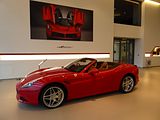
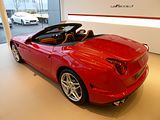
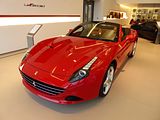
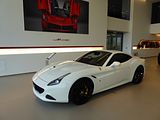
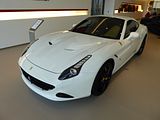
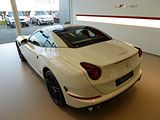
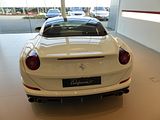
Exciting though the regular 458 Italia models are, when Ferrari revealed the 458 Speciale, common consent was that they had hit a new peak of excellence. The 458 Speciale followed a long line of specially engineered cars added to complement the “regular” V8 models that started with the 100 units of the 348 Speciale produced in 1992, and followed up by the 360 Challenge Stradale, the 430 Scuderia and the 16M. In essence they are all about adding power and shedding weight. In simplistic terms, the road to the Speciale can be summed up in four words: more power, less weight. There are other, more detailed changes, too, obviously, but those are the cornerstones around which everything else is shaped. The normally aspirated, flat-plane crank V8 retains its 4497cc swept capacity but receives new cam geometry with higher valve lift, shorter inlet manifolds and different pistons providing a higher compression ratio. Internal friction is reduced, through the use of uprated materials and the upshot is 597bhp (up from 562bhp) generated at the engine’s 9000rpm limit. Torque is the same, at 398lb ft, still delivered at 6000rpm. The engine is mated to a seven-speed, dual-clutch gearbox whose upshifts, we were told at the launch of such gearboxes, are all but instant. That’s still true, but Ferrari has improved the response time to a pull on the lever and made the engine rev-match more quickly on downshifts to reduce the time that those take. The engine’s changes shave 8kg from the car’s overall weight – the exhaust is all aluminium and the intake is carbonfibre. Those 8kg form part of a claimed 90kg total saving at 1395kg now, versus 1485kg for a 458 Italia. Of this 90kg, 12kg is contributed by lighter, forged wheels, 13kg comes from bodywork and window changes (lighter glass all round and Lexan for the engine cover), and 20kg comes from the cabin. There are two flaps on the Speciale’s front valance, one either side of the prancing horse badge in its centre. Below 106mph these flaps remain closed, which diverts air towards the radiators. Above that speed, the radiators get quite enough cool air, thanks very much, so the flaps open, which reduces drag. Then, above 137mph, they move again, lowering to shift downforce to the rear of the car, in turn adjusting the balance 20 per cent rearward in order to promote high-speed cornering stability. At the rear, meanwhile, there is a new diffuser (the exhausts have been rerouted to make the most of its central section). Movable flaps in the diffuser adjust, but this time they are dependent not only on speed but also on steering angle and throttle or brake position. When lowered, the flaps stall the path of air into the diffuser and improve the Cd by 0.03. When raised, the diffuser adds downforce as it should. Bodywork changes, though, also bring some aerodynamic improvements, you’ll not be surprised to hear, with lessons applied from the LaFerrari and FXX programmes. In the front valance and under the rear diffuser, there are flaps that open at speed to reduce drag and improve downforce. Finally, there are new Michelin Pilot Sport Cup 2 tyres in a unique compound – rather a sticky one, we suspect – plus new calibration for the adaptive dampers. The carbon-ceramic brake discs also use a new compound. 499 of them were built and they sold out very quickly.
Just 458 of the open topped version, the 458 Speciale A (for Aperta), launched at the 2014 Paris Show, were built, I’ve never seen one before. To find one that matches the Coupe model on show was was the case here was really rather “Special-e”. The mechanical changes to this car are the same as with the Coupe model, and that goes for the styling alterations as well, with the major difference being that, as this is an open car, with a removable roof, you no longer get the glass engine cover. Weighing 50 kg more than the closed car, the quoted performance figures for the two models were the same. Inside. the Speciale A gets blue carbonfibre – exclusive to this model – on the dash, moulded door panels and central tunnel, as well as the newly designed seats in Alcantara with contrasting stitching and 3D technical fabric. A special plaque in the cockpit commemorates the three international ‘best performance engine’ awards the V8 has won.
In a large area to one side of the showroom are the pre-owned cars, and this is where you can see plenty of examples of models from the back catalogue.
As well as examples of the recent 458 Italia and Spider there was one further 458 Speciale and another Speciale A
Other current or recent cars included the California and California T, the big FF and the current F12 Berlinetta
The 360 and 430 models were the biggest selling Ferraris of all time, and there are large numbers of them in the UK (by Ferrari standards). The same basic design ran from the 360 Modena of 1999 to the last of the F430 and Spider cars in 2010. There were plenty of different versions as well as the “regular” Coupe and Spider models, with the 360 Challenge Stradale, a special edition version of the 360 model launched in 2003, being the one seen here as well as a couple of F430 cars.
At the top of the range from 2006 until 2012 was the 599GTB, an elegant V12 engined GT car and there was one of these on offer.
Firmly placed in Ferrari’s history as one of their finest big GTs, the 550 Maranello’s combination of stylish Pininfarina lines and front mounted 12-cylinder engine meant this car had the potential to become an instant classic, following in the footsteps of its forebear, the 365 GTB/4 ‘Daytona’, and if you look at the way the prices are steading to go, it’s clear that the potential is being realised. Launched in 1996, and with modern styling cues, a 5.5 litre V12 engine producing around 485bhp and a reported top speed of 199mph, the 550 Maranello was a serious motor car. A less frenetic power delivery, the six speed manual box and excellent weight distribution were all factors in the 550 becoming the perfect European Grand Tourer. Ferrari updated the car to create the 575M
Joining the “regular” cars was an example of one of the two different open-topped models that Ferrari produced in very limited quantities. This is the later of the two, the first being the 550 Barchetta, an example of which was in the workshop on my third visit, and is a 575M Superamerica. Based on the 575M Maranello; it featured an electrochromic glass panel roof which rotated 180° (both of these attributes being production car firsts) at the rear to lie flat over the boot. The patented Revocromico roof incorporates a carbon fibre structure that is hinged on the single axis with a luggage compartment lid, allowing the access to the latter even with an open roof. With the roof open the rear window, apart for holding the third stop light, also acts as a wind deflector. This roof design was previously used on the 2001-designed Vola by Leonardo Fioravanti. The Superamerica used the higher-output tune of the V-12 engine, F133 G, rated at 533 hp and Ferrari marketed it as the world’s fastest convertible, with a top speed of 199 mph. The GTC handling package was optional. A total of 559 Superamericas were built; this number followed Enzo Ferrari’s philosophy that there should always be one fewer car available than what the market demanded.
A trio of older Ferrari models were also to be seen. Considered by many to be one of the prettiest Ferrari models ever made, is this Dino 246 GTB, a second example of which was to be seen in the workshops on one of my visits. Created to honour Alfredo ‘Dino’ Ferrari, Enzo Ferrari’s only legitimate son, who sadly died of muscular dystrophy in 1956, unlike any previous road-going Ferrari, the Dino used a V6 engine, the Tipo 156, which Alfredo himself had helped develop and strongly advocated during his working life. Following continued motor racing success and in order to homologate Ferrari’s 1966 Formula Two campaign, a new line of mid-engined production V6 coupés with Fiat running gear went on sale in 1967 in two litre form. The voluptuous bodywork of the Dino, which many regard as the prettiest ever to grace a road-going Ferrari, was designed by Pininfarina and built by Scaglietti. It clothed a tubular chassis which carried wishbone independent suspension at each corner. The compact four-cam, 190bhp. engine was mounted transversely above the five-speed gearbox and just ahead of the rear axle, allowing for both a comfortable cockpit and some usable boot space. In 1969 a larger-engined 2.4 litre Dino was introduced, named the 246 GT or GTS in the case of the Spider. Only 3,913 definitive Dinos were built before the introduction of the completely restyled V8 engined 308 in 1973. Values of these cars have rocketed in recent years, with people paying hundred s of thousands now for what you could have acquired for a five figure sum not that many years ago. A second one of these was in the workshops at the time of my early March visit.
Dating from the 1970s was this car, once considered “the” supercar, the Berlinetta Boxer. The model seen here is the 512 BB, the second generation of this legendary icon, with a more potent 12 cylinder boxer engine used to power it. Enzo Ferrari, contrary to his engineer’s wishes, had delayed the introduction of a mid-engine car, doubting the ability of his customer base to handle this configuration, but finally relented with the launch of the DIno. In 1971 a more powerful model, the flat 12 engined 365 GT4 BB was shown, reaching customers in 1973. Competing with the new Lamborghini Countach, and to some extent the rather more practical Maserati Bora, this was as extreme as supercars got in the early 1970s. In the autumn of 1976, Ferrari upgraded the model in a number of key respects and dusted off the legendary 512 name that had been used on successful racing cars a few years earlier. With the BB512, the engine capacity was increased to nearly five litres and a dry sump fitted, then with suspension changes and various modifications Ferrari was back at number one in the supercar pecking order. The competence of the 512 BB was re-iterated by the world’s motoring press as many of them proclaimed this Ferrari as the best all round Sports GT of the day in 1976. A mere 929 512 BB models were manufactured between 1976 and 1981, of which only 101 were in right-hand drive form.
Successor to the BB512 was the Testarossa, which was launched at the Paris Show in October 1984. The Pininfarina-designed car was produced until 1991, with the same basic design then going through two model revisions, with the 512 TR and later F512 M which were produced from 1992 to 1996 before the model was replaced by the front-engined 550 Maranello. Almost 10,000 Testarossas, 512 TRs, and F512 Ms were produced, making it one of the most-produced Ferrari models, despite its high price and exotic design. In 1995, the F512 M retailed for £136,500. The Testarossa followed the same concept as the BB512, the model it replaced, but was intended to fix some of the criticisms of the earlier car, such as a cabin that got increasingly hot from the indoor plumbing that ran between the front-mounted radiator and the midships-mounted engine and a lack of luggage space. This resulted in a car that was larger, and at 1,976 millimetres (78 in) wide the Testarossa was half a foot wider than the Boxer and immediately condemned for being too wide, though these days it does not appear anything like as wide as it did when new. This resulted in an increased wheelbase that stretched about 64 mm (2.5 in) to 2,550 mm (100 in) which was used to accommodate luggage in a carpeted storage space under the front forward-opening lid. The increase in length created extra storage space behind the seats in the cabin. Headroom was also increased with a roofline half an inch taller than the Boxer. The design came from Pininfarina with a team of designers led by design chief Leonardo Fioravanti, the designer of many contemporary Ferraris. The design was originated by Nicosia, but the guidance of Fioravanti was equally important. Being a trained aerodynamicist, Fioravanti applied his know-how to set the aerodynamics layout of the car. This meant the large side intakes were not only a statement of style but actually functional – they drew clean air to cool the side radiators and then went upward and left the car through the ventilation holes located at the engine lid and the tail. As a result, the Testarossa did not need a rear spoiler like Lamborghini’s Countach yet produced zero lift at its rear axle. The aerodynamic drag coefficient of 0.36 was also significantly better than the Lamborghini’s 0.42. Pininfarina’s body was a departure from the curvaceous boxer—one which caused some controversy. The side strakes sometimes referred to as “cheese graters” or “egg slicers,” that spanned from the doors to the rear wings were needed for rules in several countries outlawing large openings on cars. The Testarossa had twin radiators in the back with the engine instead of a single radiator up-front. In conjunction the strakes provided cool air to the rear-mounted side radiators, thus keeping the engine from overheating. The strakes also made the Testarossa wider at the rear than in the front, thus increasing stability and handling. One last unique addition to the new design was a single high mounted rear view mirror on the driver’s side. On US based cars, the mirror was lowered to a more normal placement in 1987 and quickly joined by a passenger side rear view mirror for the driver to be able to make safe easy lane changes. Like its predecessor, the Testarossa used double wishbone front and rear suspension systems. Ferrari improved traction by adding 10-inch-wide alloy rear wheels. The Testarossa drivetrain was also an evolution of the BB 512i. Its engine used near identical displacement and compression ratio, but unlike the BB 512i had four-valve cylinder heads that were finished in red. The capacity was 4,943 cc, in a flat-12 engine mid mounted. Each cylinder had four valves, lubricated via a dry sump system, and a compression ratio of 9.20:1. These combined to provide a maximum torque of 490 Nm (361 lb/ft) at 4500 rpm and a maximum power of 390 hp at 6300 rpm. That was enough to allow the Testarossa to accelerate from 0–60 mph in 5.2 seconds and on to 100 mph. The original Testarossa was re-engineered for 1992 and released as the 512 TR, at the Los Angeles Auto Show, effectively as a completely new car, with an improved weight distribution of 41% front: 59% rear. The F512 M was introduced at the 1994 Paris Auto Show, with the M standing for “modificata”. That car is easy to spot as it lost the pop-up headlights and gained awkward glazed in units.
On my early March visit, just as I was about to leave, the large roller shutters of the workshop were raised, and I could glance inside. Imagine my delight to see an F12 TdF up on the ramps. Apologies for the distant shot, but it is the best I could manage. Returning a few days later, I asked if it was still there, and the answer is that it was, now mounted up in the air on a ramp, and I was taken into the workshop for a closer look. I can now say that I have stood underneath a TdF. As you might expect, there is not much to see, as there is a large cover with only a couple of strategically placed openings to allow heat out from around the catalysts. Apparently, Dick Lovett will be getting 8 of the UK’s allocation of TdF’s, an increase from the 6 they were initially expecting, as they managed to sell an FXX car recently, which gave them extra “credit” with Maranello. What that means is that they can now satisfy the demand from a couple of other prospects. The lucky person who has bought this TdF also has ( probably among many other cars) an Enzo (which was also in the workshop and a La Ferrari).
As my host said, “we do get some cool cars here. Indeed, there is almost always something interesting on site”. He was not wrong there!

